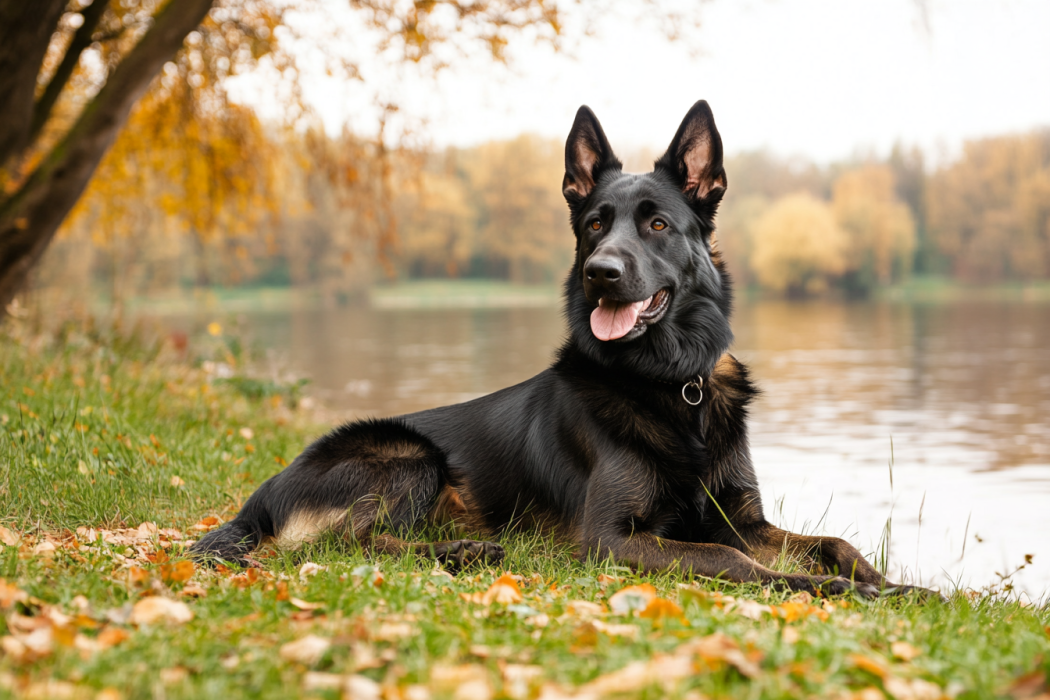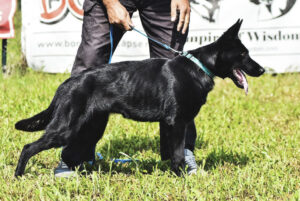Training Working Line and Show Line German Shepherds
German Shepherds can be divided into two subsets. One of these is known as the working line German Shepherd. The other is the show line German Shepherd. As a breed, German Shepherd Dogs (GSDs) are known to be active dogs with a high drive. But are they easy to train. This is the question this article intends to address. This question matters, especially if you’re thinking about bringing one into your home. Training any dog takes a lot of time and effort. So you might want to know whether the puppy you are bringing home will be easily trained. As will be clear by the end of the article. Over the last century, the GSD as a breed has morphed into two clear and distinct groups. On the one hand show line dogs have slowly morphed into one direction, while the working line German Shepherd has stayed more in line with the GSD breed from eighty to one hundred years ago. Here at Czech Working Line, we only breed working line German Shepherd Dogs. By the end of this article it should be more clear why we never, ever mix show lines into our breedings. Here in this article we will make a case for why if you want a highly trainable dog, it 100% makes sense to stick with finding a working line German Shepherd puppy for sale.
1. German Shepherds Have Been Bred For With A Desire to Please
German Shepherds want to work with their owners. They thrive on learning new tasks and following commands. This makes training them a rewarding experience. They quickly pick up basic commands like sit, stay, and come. They enjoy being part of the action and pleasing their handlers.
The bond you build during training strengthens their willingness to learn. A strong relationship creates trust. This trust makes them more eager to follow your lead. When they feel included, they work harder. But, not all GSDs are bred equal. Show line dogs have arguably been primarily bred for conformation, this meaning, what they look like. Show dogs are put in a show ring and judged like a beauty pageant. They are judged based on what they look like. While conformation also matters to the working line German Shepherd breeder, for working line German Shepherds, the primary matter of concern is their ability to demonstrate a clear and provable ability to perform at a high level in obedience, tracking and protection work. These dogs are tested against an objective standard. This desire to please has been specifically selected for highly obedient dogs capable to thriving in environments where they demonstrate a high level of ability to obey, to track scents in a search and rescue environment, as well as guarding and learning protection work. It kind of makes sense that dogs selected for what they look like, dogs that are not tested in virtually every generation. Well, they will lose these traits. Slowly over time, they will lose the ability to train easily (biddable). They will become less and less biddable as form is valued over function. Contrast this with the working line German Shepherd puppy where breeding stock are regularly excluded on the basis of not easily able to be trained. Excluded on the basis that not enough drive exists for the dog to thrive in protection work. Without a doubt, finding working line German Shepherd puppies for sale that come from titled parents who for generations have been tested against an objective standard. These are the kind of dogs that will put a smile on your face.
2. German Shepherds Have Been Bred As A Higher Drive Dog Breed
German Shepherds have lots of energy. This means they need daily physical and mental activities. A bored dog can become restless and act out. Training helps channel their energy into positive behaviors. Activities like agility, fetch, and obedience drills keep them engaged.
Their stamina is ideal for long training sessions. They don’t tire easily, which allows for extended practice. But balance is key. Overworking them can lead to frustration. Short, focused sessions work best.
3. Socialization is Key For Your Working Line German Shepherd Puppy
Early socialization is a must for German Shepherds. It helps them become confident and well-mannered. Introducing them to new people, places, and animals at a young age prevents fear or aggression later. Socialization teaches them how to behave in different settings.
Take them to parks, training classes, or busy areas. Reward calm behavior and guide them through new experiences. This builds a solid foundation for future training. A well-socialized German Shepherd is more adaptable and relaxed.
4. Consistency Matters For Your German Shepherd Puppy
German Shepherds thrive on routine. Consistent commands and schedules help them understand expectations. Mixed signals can confuse them. Stick to the same words and gestures for commands. For example, always use “down” instead of switching between “lay” or “lie down.”
Training requires patience. Repetition helps reinforce lessons. Over time, they will respond reliably. Consistency also builds trust. They learn to depend on your guidance.
5. Food and Play as Rewards
Positive reinforcement works wonders with German Shepherds. Treats, toys, and praise motivate them to perform well. Find what excites your dog the most. Some may prefer a tasty treat, while others enjoy a game of tug.
Using rewards makes training fun. It creates a positive association with learning. Keep sessions upbeat and engaging. Avoid punishment-based methods, as they can harm the bond with your dog. Instead, focus on celebrating their successes.
6. Intelligence Supports Learning
German Shepherds are quick learners. They grasp complex tasks faster than many other breeds. This makes them excellent for advanced training like search-and-rescue or scent detection. Their ability to focus and solve problems sets them apart.
Teaching tricks or commands is easier when they are engaged. Break tasks into small steps. Reward progress along the way. This builds confidence and keeps them motivated.
7. Challenges to Keep in Mind When Training GSDs
While German Shepherds are trainable, they aren’t perfect. Their independent streak can sometimes lead to stubbornness. They may test boundaries, especially during adolescence. Staying firm and patient helps overcome these phases.
Proper training requires time and commitment. Without it, they can develop bad habits. Consistent effort ensures they grow into well-behaved companions. Seek professional help if needed. Trainers can guide you through challenges.
8. Lifelong Training
Training doesn’t stop after puppyhood. German Shepherds benefit from ongoing practice. Regular refreshers keep their skills sharp. Advanced training or sports can provide mental stimulation. This keeps them happy and prevents boredom.
Building on basic obedience strengthens your bond. It also ensures they remain responsive as they age. Lifelong training creates a fulfilling relationship for both you and your dog.
Conclusion
Working line German Shepherds (Alsatian Shepherds– another name for German Shepherds) are highly trainable dogs. Their eagerness to please and quick learning abilities make them stand out. However, successful training requires consistency, patience, and effort. Early socialization and positive reinforcement are crucial. With the right approach, they become exceptional companions and protectors. Whether you’re teaching basic commands or advanced skills, working line German Shepherds rise to the challenge. With time and dedication, they prove to be one of the best breeds to train.
Bibliography
- Blackwell, E. J., Twells, C., Seawright, A., & Casey, R. A. “The Relationship Between Training Methods and the Occurrence of Behavior Problems in Domestic Dogs.” Journal of Veterinary Behavior, vol. 3, no. 5, 2008, pp. 207-217.
- Hiby, E. F., Rooney, N. J., & Bradshaw, J. W. S. “Dog Training Methods: Their Use, Effectiveness, and Interaction with Behavior and Welfare.” Animal Welfare, vol. 13, no. 1, 2004, pp. 63-69.
- Lindsay, S. R. Handbook of Applied Dog Behavior and Training, Volume One: Adaptation and Learning. Iowa State University Press, 2000.
- McGreevy, P., & Boakes, R. Carrots and Sticks: Principles of Animal Training. Cambridge University Press, 2007.
- Rooney, N. J., & Cowan, S. “Training Methods and Owner-Dog Interactions: Links with Dog Behavior and Learning Ability.” Applied Animal Behaviour Science, vol. 132, no. 3-4, 2011, pp. 169-177.
- Serpell, J. A., & Jagoe, J. A. “Early Experience and the Development of Behavior.” In J. A. Serpell (Ed.), The Domestic Dog: Its Evolution, Behavior, and Interactions with People. Cambridge University Press, 1995, pp. 79-102.
- Svobodová, I., Víchová, P., & Bártová, M. “Temperament and Behavioral Traits in Working Line Dogs.” Journal of Canine Behavior, vol. 9, no. 4, 2012, pp. 213-225.
- Vas, J., Topál, J., Gácsi, M., Miklósi, Á., & Csányi, V. “A Friend or an Enemy? Dogs’ Reaction to an Unfamiliar Person Showing Behavioural Cues of Threat and Friendliness at Different Times.” Applied Animal Behaviour Science, vol. 74, no. 3, 2001, pp. 235-253.
- Yin, S. Low Stress Handling, Restraint, and Behavior Modification of Dogs and Cats. CattleDog Publishing, 2009.
- Ziv, G. “The Effects of Using Aversive Training Methods in Dogs: A Review.” Journal of Veterinary Behavior, vol. 19, 2017, pp. 50-60.




